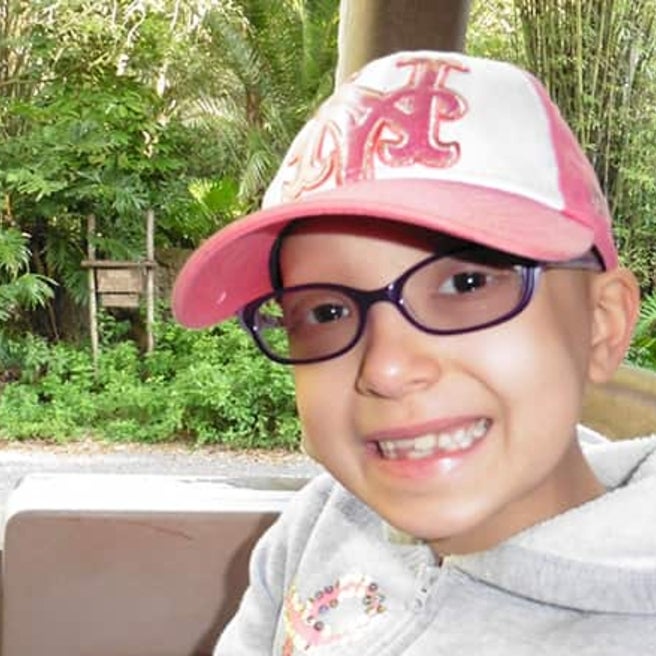What is Ewing sarcoma?
Ewing sarcoma is the second most common malignant (cancerous) bone tumor affecting children, adolescents and young adults, but it is still a rare disorder. Approximately 250 cases are diagnosed each year in the United States.
Ewing sarcoma is a cancer, which means it can spread to other organs or tissues in the body, most commonly starting with the lungs, bone or bone marrow.
Most Ewing sarcoma tumors are found in teenagers, but the disease can also occur at a younger age. Caucasian children, particularly boys, are far more likely to have Ewing sarcoma than any other racial or ethnic group.
Causes of Ewing sarcoma in children
Ewing sarcoma is characterized by chromosome changes that occur after birth. In a process known as translocation, chromosomes 11 and 22 “swap” small pieces of each other. The result is an abnormal gene that can be detected with DNA testing.
It is not known why the Ewing sarcoma translocation occurs.
The cause of Ewing sarcoma is genetic — in that it comes from genetic changes in tumor cells — but it is not inherited like some other childhood cancers. Parents can’t pass along the genetic changes associated with Ewing sarcoma to their children.
Signs and symptoms of Ewing sarcoma in children
The symptoms of Ewing sarcoma depend on the size and location of the tumor, as well as your child’s age and general health.
Indications may include:
- Pain, stiffness or tenderness at the site of the tumor
- Pain that gets progressively worse over time, and may radiate outward from the tumor site
- Pain that awakes the child from sound sleep
- Swelling or mass around the affected bone
- Decreased motor skills, including difficulty walking or limping
- Weak bones, which may lead to a fracture
- Fatigue
- Weight loss
- Fever
- Anemia
A Ewing sarcoma located near the spinal cord may cause back pain that radiates out through the arms or legs, or sometimes numbness or weakness.
Testing and diagnosis for Ewing sarcoma in children
Some symptoms of Ewing sarcoma can be easily ignored as normal growing pains in children, which makes regular check-ups and referrals to specialists extremely important.
If your child has been referred to an orthopedic or oncology specialist, your child’s diagnostic evaluation begins with a thorough medical history and physical examination. A detailed neurological assessment may also be performed. This involves a series of questions and tests to check the brain, spinal cord and nerve function.
At Children’s Hospital of Philadelphia (CHOP), clinical experts use a variety of diagnostic tests to diagnose tumors, including:
- X-rays, which produce images of bones.
- Magnetic resonance imaging (MRI), which uses a combination of large magnets, radiofrequencies and a computer to produce detailed images of organs, soft tissues, muscles, ligaments and other structures within the body. Your child is exposed to no radiation during an MRI.
- Computed tomography (CT) scan, which uses a combination of X-rays and computer technology to examine bones and produces cross-sectional images ("slices") of the body.
- Positron emission tomography (PET) scan, which uses radioactive sugar injected into a vein and a scanner to make detailed, computerized pictures of areas of the body.
- Needle biopsy, which is a procedure where a doctor places a small needle through the skin and into the lesion to withdraw a small sample of the abnormal tissue. The tissue is analyzed to confirm any findings.
- Bone marrow aspiration, a procedure in which a small amount of bone marrow fluid and cells are obtained by a needle inserted into a bone to check for problems with any of the blood cells made in the bone marrow.
In addition to diagnosing the specific type of cancer, these tests will also help determine the size and location of the tumor, and stage of the cancer. All this information is crucial in determining the best treatment option for your child.
Treatments for Ewing sarcoma in children
There are many treatment options available for bone and soft tissue tumors, and some children will need a combination of these therapies. The Bone and Soft Tissue Tumor Program at CHOP takes a team approach to treatment. Your child’s care team may include experts from several areas of medicine, including pediatric orthopedic surgery, diagnostic or interventional radiology, oncology, radiation oncology and more, who collaborate to provide your child with individualized care and the best possible outcomes.
Chemotherapy
In addition to treatment of the primary tumor, treatment for Ewing sarcoma always involves chemotherapy to target cancer cells that may have already spread but have not yet been detected. Chemotherapy refers to medicines that help fight cancer.
In most cases, chemotherapy is given to your child through an implantable venous port in the chest. The port remains in place for the duration of therapy to help your child avoid multiple needle sticks.
Local Control
There are two options that may be used alone or together to treat the primary tumor: surgery and radiation therapy. We use a multidisciplinary approach to determine which option is best for each patient based on the location of their tumor.
Surgery
Surgery for Ewing sarcoma has two goals:
- To remove the tumor
- To restore function at the site of the tumor
Most children with Ewing sarcoma of an extremity (arm or leg) can be treated with limb-sparing (also known as limb-salvage) and reconstructive surgery. CHOP surgeons regularly perform these complex surgeries and are constantly working to improve outcomes for children with the most difficult-to-treat tumors.
Limb-sparing surgery is performed under general anesthesia. It involves cutting out the tumor and a margin of health tissue surrounding it. Depending on the size and location of the tumor, as well as your child’s age and stage of growth, surgeons may use a variety of reconstructive methods to restore your child’s body function.
Reconstruction may include:
- Joint replacement if your child’s Ewing sarcoma is located on or near the knee, hip or shoulder. If your child is still growing, a modified joint replacement that can be expanded as your child grows, may be used.
- Allograft (cadaver bone) if your child’s tumor is in the middle of an arm or leg bone. This replacement bone serves as a structural filler — giving the limb more strength and durability as your child’s own bone grows around it.
- Free vascularized fibular grafting if your child’s tumor is in the thigh bone. This procedure includes moving one bone from your child’s lower leg to replace a diseased thigh bone. This may be done along or in conjunction with an allograft.
In about 10% of patients with Ewing sarcoma of an extremity — because of the size or location of the tumor — the tumor cannot be removed with limb-sparing surgery. In these rare situations, two surgical options exist:
- Amputation of the affected limb.
- Functional amputation (rotationplasty). CHOP is one of a limited number of hospitals offering this complex surgery in which the ankle assumes the function of a knee. Children can resume active lifestyles and have almost normal function.
Ewing sarcomas that appear in other locations in the body (head and neck or trunk) and require specialized surgery will be treated by a surgeon with expertise in that area of the body.
After surgery for Ewing sarcoma, your child should expect to stay two to five days in the hospital.
Surgical safety
Though surgery for malignant tumors is highly effective, we understand that any surgery can be a stressful experience for children and families. At CHOP, we offer a wealth of resources about how to prepare your child for surgery and what to expect during surgery.
Additionally, we employ numerous best practices before, during and after surgery to decrease the risk of infection and increase positive outcomes. For more details about safety protocols at Children's Hospital of Philadelphia, see safety in surgery.
Radiation therapy
Depending on your child’s individual situation, radiation therapy may be recommended. The radiation destroys or damages cancer cells so they cannot grow or spread.
The goal of radiation treatment is to damage as many cancer cells as possible, while limiting harm to nearby healthy cells. To protect healthy cells, your doctor will carefully plan the dose of radiation and space the treatment over time.
We offer pediatric proton therapy in collaboration with Penn Medicine at the Roberts Proton Therapy Center. Proton therapy is an innovative form of radiation treatment that is only available at very few hospitals across the nation. The greatest benefit of proton therapy is that it delivers most of its energy to a very narrow field at the location of the tumor — making it less damaging to the surrounding healthy tissue.
Follow-up care
Regular monitoring by trained clinicians is strongly encouraged to check for possible recurrence of the growth and manage any side effects of treatment. Ewing sarcoma can reoccur — even after being successfully treated — so it is important for your child continue to be seen regularly by one of the physicians at the Bone and Soft Tissue Tumor Program.
If surgery was performed, your child will be examined by the surgeon about one to two weeks after surgery, then again at three and six months post-surgery. If your child had reconstructive surgery, long-term follow-up care will be needed to monitor the joint replacement, allograft or fibular grafting. Children who had a limb amputation or rotationplasty will need to be fitted with a prosthetic, and routine adjustments will be needed as they grow.
During follow-up visits, MRIs, CT scans, X-rays and other diagnostic testing of the tumor site or other areas may be recommended to closely monitor your child’s health and make sure there is no recurrence.
Follow-up care and ongoing support and services are available at our Philadelphia Campus and throughout our CHOP Care Network. Our team is committed to partnering with parents and referring physicians to provide the most current, comprehensive and specialized care possible for your child.
If continued monitoring into adulthood is needed, your child can continue to see some of the same doctors. CHOP’s Bone and Soft Tissue Tumor Program works closely with Penn Medicine. For families who live farther away and need continued monitoring, our clinical professionals will help your child transition to adult care near your home.
Outlook
CHOP has an excellent track record of improving the quality of life for children diagnosed with Ewing sarcoma.
As with any cancer, prognosis and long-term survival can vary greatly from child to child, however. Prompt medical attention and aggressive therapy are important for the best prognosis.
Some children treated for pediatric cancer develop complications years later. Our Cancer Survivorship Program provides information about the potential long-term effects of the specific treatment your child received, including ways of monitoring and treating these effects.

Would you like a second surgical opinion from a CHOP expert?
Our referral nurse navigator can give your family timely access to world-renowned pediatric orthopedic surgeons in every specialty.
Resources to help
Ewing sarcoma Resources
Bone and Soft Tissue Tumor Program Resources
We have compiled web, video and other resources to help you find answers to your questions and help you feel more confident in the care you are providing your child.
Reviewed by Alexandre Arkader, MD, Theodore W. Laetsch, MD


